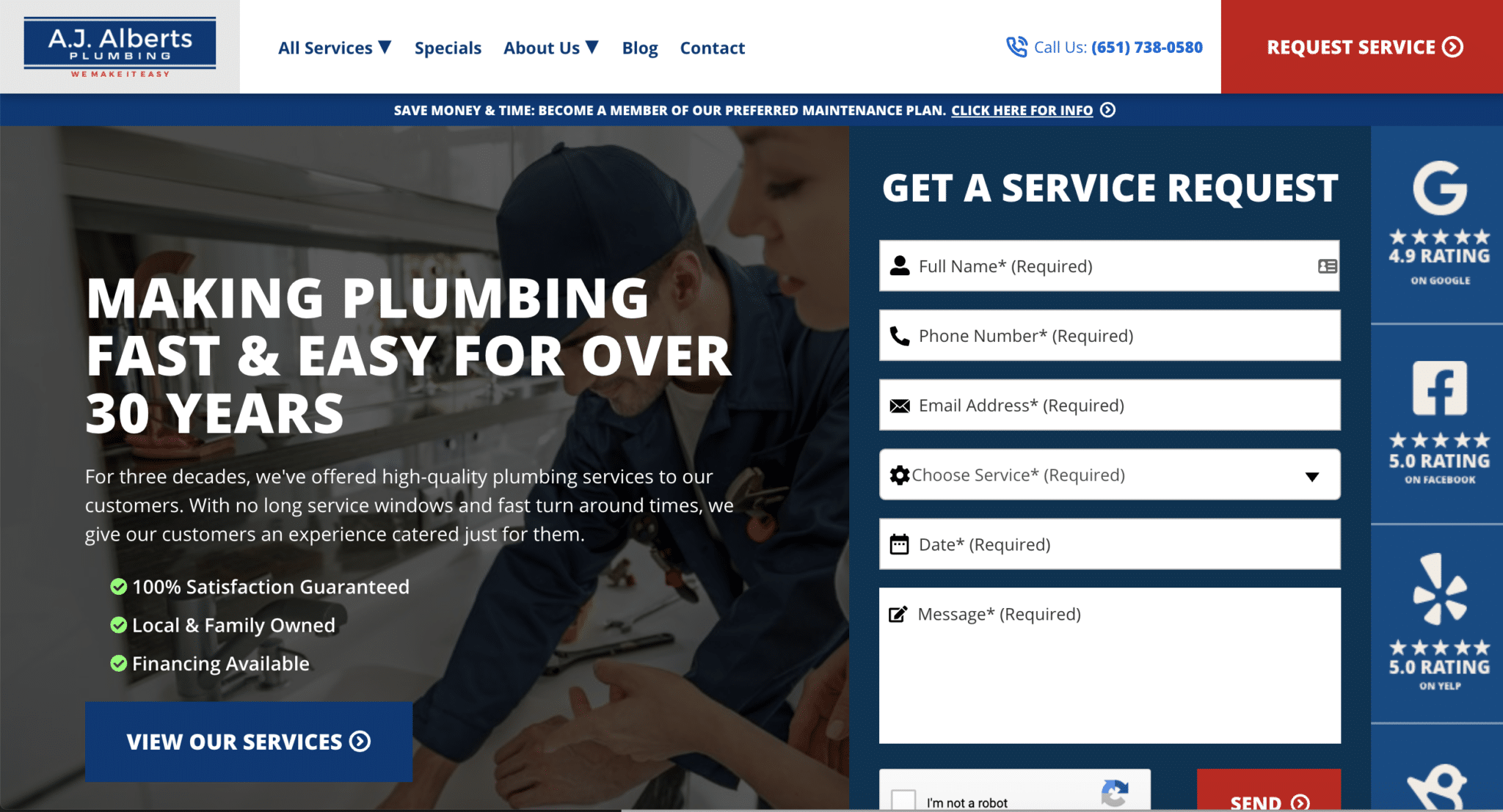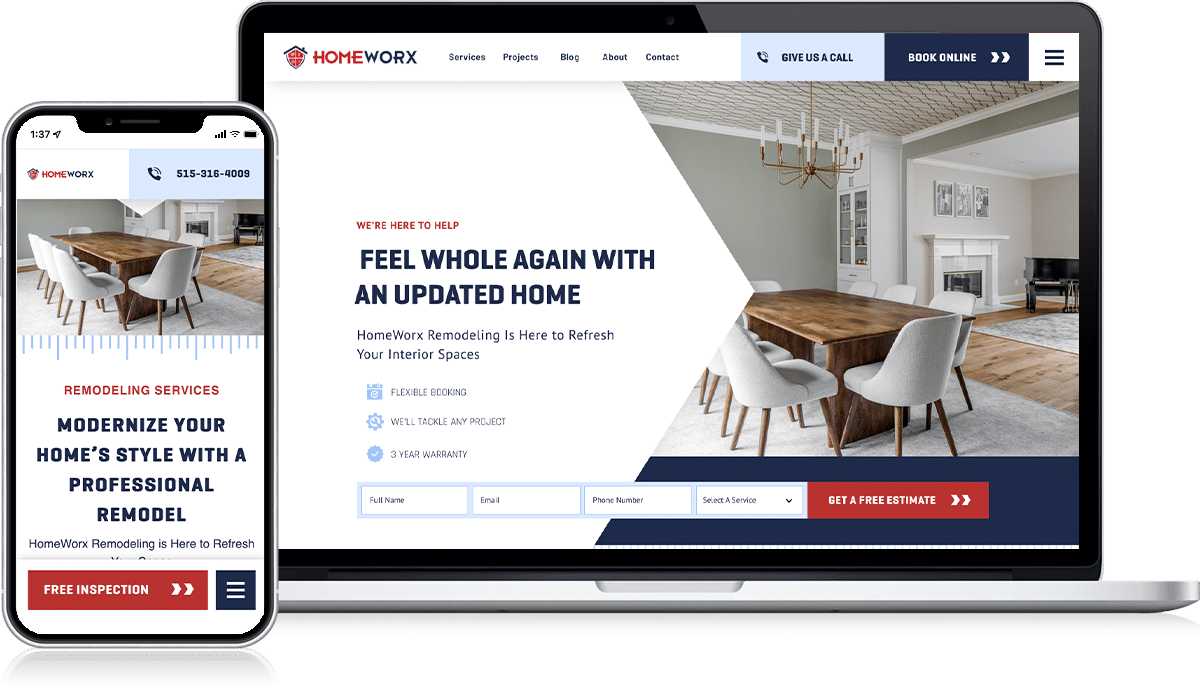In 2024, the home services industry is more competitive than ever, making it crucial for businesses to have a strong online presence. With a well-designed website, home service companies can showcase their expertise, attract potential customers, and ultimately drive revenue. In this blog post, we’ll delve into the essential features of home services web design, explore strategies for boosting visibility with search engine optimization (SEO), offer guidance on choosing the right web designer, and discuss leveraging your website for lead generation.
Short Summary
-
Successful home services web design should incorporate user-friendly UI/UX, engaging graphic design and optimized loading speed.
-
Leverage SEO strategies such as keyword research & on-page optimization to boost website visibility.
-
Incorporate persuasive calls to action, customer testimonials & unique solutions into the website for lead generation.
7 Exciting Home Services Website Design Examples to Inspire You
1. Paladin Plumbing – Plumbing Website Example
Complete with fresh and bold illustrations, trust factors, and copywriting 100% focused homeowners.

2. Mars Restoration – Home Services Website Example
Also totally focused on the homeowner here, rather than a hero shot of the roof – this design focuses on the people that are enjoying the roof.

3. Electric City – Electrician / Electrical Web Design Example
Once again going the illustration route, this bold design is high-contrast, and highly modern.

4. Degree HVAC Services / Home Services Website Design Inspiration
Clean whitespace, and comforting design, testimonials take the center stage on this home services website design.

5. A.J. Alberts Plumbing Website Design Example
This was not a full redesign, but we wanted to make the lead form front and center, right alongside Google, Facebook and Yelp ratings.

6. Roof Troopers Roofing / Home Services Website Example
We love this new roofing brand! It makes the design elements more playful, and the design of this roofing website benefitted quite a bit.

7. Homeworx – Remodeling / Home Improvement Web Design Example
Clean and sharp design, angles and gorgeous completed kitchens and bathrooms make this design stick out against it’s competitors.

Essential Features of Home Services Web Design
An effective home services website should have three key elements: a user-friendly interface, engaging graphic design, and optimized loading speed. These features ensure that potential customers can easily find the information they need, be captivated by the site’s aesthetics, and won’t lose patience waiting for pages to load.
In the following sections, we’ll delve deeper into each of these crucial components, discussing the importance of user interface (UI) and user experience (UX), the role of graphic design in creating an attractive website, and the significance of optimizing loading speed for both user satisfaction and search engine rankings.
User Interface (UI) and User Experience (UX)
UI and UX are paramount in home services web design, as they ensure that a website is not only visually appealing but also functional and optimized for mobile devices. A seamless user experience is critical for home service companies, as it allows potential customers to easily locate the information they require and navigate through the site effortlessly, increasing the chances of converting visitors into clients.
By incorporating aesthetics and mobile-friendliness into a home services web design, businesses can create an engaging and attractive platform that appeals to their target audience. This ultimately results in a higher conversion rate and a more successful online presence for the company.
Engaging Graphic Design
An attractive and professional-looking home services website is crucial for capturing the attention of potential customers. Color schemes, typography, and visual hierarchy play a significant role in creating an engaging design that reflects the company’s brand identity and communicates its unique selling points.
Hiring a professional designer for your home services website is a wise investment, as they can ensure a clear and intuitive navigation experience for website visitors. This allows users to easily accomplish their desired tasks on the site, such as finding information about the services offered, requesting a quote, or booking an appointment, ultimately leading to higher conversion rates and a more successful online presence.
Optimizing Loading Speed
Loading speed is a critical factor in providing a positive user experience and improving a website’s online ranking on search engines such as Google. A slow-loading website can lead to higher bounce rates, lower conversion rates, and a negative impact on search engine rankings. In fact, a study by Portent revealed that website conversion rates decrease by an average of 4.42% for each additional second of load time.
To enhance website performance, consider optimizing images, minifying code, leveraging browser caching, and utilizing a content delivery network. By implementing these strategies, businesses can ensure their home services website loads quickly, providing a seamless user experience and improving their search engine rankings.
Boosting Visibility with SEO
Search engine optimization (SEO) is essential for home services websites to attract more visitors and potential customers. By optimizing your website for search engines like Google, you can increase your online visibility and drive more traffic to your site, ultimately leading to higher conversion rates and business growth.
In the following sections, we’ll explore various SEO strategies, including keyword research, on-page optimization, and local SEO, to help you boost your website’s visibility and attract more potential customers.
Keyword Research
Keyword research is the process of identifying pertinent keywords that can enhance your website’s search engine rankings. By targeting the right keywords, home services businesses can attract a relevant audience, enhance conversion rates, gain consumer behavior insights, drive additional website traffic, and optimize search rankings for targeted keywords.
The process for conducting keyword research involves brainstorming a list of relevant keywords, utilizing keyword research tools to assess competition and search volume, considering the intent and context associated with each keyword, and prioritizing keywords based on relevance and potential impact.
By incorporating well-researched keywords into your website content, you can increase your website’s visibility on search engines and attract more potential customers.
On-page Optimization
On-page optimization, or on-page SEO, is the process of optimizing individual web pages to enhance their search engine rankings and increase website traffic. This encompasses optimizing components like page titles, meta descriptions, headings, images, and internal links.
Some essential on-page SEO factors for home services websites include meta tags, header tags, and image optimization. By optimizing these elements, businesses can increase their visibility on search engines, drive more traffic to their website, and ultimately generate more leads and revenue.
In the following sections, we’ll discuss best practices for optimizing meta tags, header tags, and images for home services websites.
Local SEO
Local SEO is an essential aspect of search engine optimization for home service companies, as it helps to boost visibility on search engines through the use of Google My Business listings, online reviews, and localized content. By optimizing your website for local search, you can attract more potential customers in your service area and increase your chances of converting them into clients.
Creating and completing a Google My Business profile, collecting positive online reviews, and incorporating localized content into your website can all contribute to improved local SEO rankings. By implementing these strategies, home service companies can increase their online visibility, attract more potential customers, and ultimately grow their business.
Choosing the Right Web Designer for Your Home Services Business
Selecting the right web designer for your home services company is crucial for the success of your online presence. Factors such as experience, portfolio, and industry knowledge should be taken into account when choosing a web designer, as they can help ensure a tailored and effective website design.
In the following sections, we’ll provide tips on assessing a web designer’s portfolio, evaluating their industry expertise, and the importance of communication and collaboration between the business owner and the web designer to achieve the desired website outcome.
Assessing Portfolios
Reviewing a web designer’s portfolio is an essential step in selecting the best designer for your home services website. A designer’s portfolio showcases their skills and expertise in creating websites for various industries, including home services.
By assessing a designer’s portfolio, you can evaluate their proficiency and knowledge in developing home services websites, as well as their ability to create visually appealing and user-friendly designs. This information can help you make an informed decision when selecting a web designer for your home services company.
Industry Expertise
Choosing a web designer with specialized knowledge of the home services industry can provide a more tailored and effective website design. Web designers with industry expertise are familiar with the unique challenges and requirements of home service companies, allowing them to create custom websites that effectively address the needs of both the business and its customers, including the development of a home service website.
Having industry expertise can also provide invaluable insights into the latest trends and modifications in the industry, helping to ensure the website is effective and current. By selecting a web designer with home services industry expertise, businesses can ensure a customized and effective website design that caters to their specific needs.
Communication and Collaboration
Open communication and collaboration between the business owner and the web designer are essential to guarantee that the desired website outcome is attained. Establishing a strong working relationship with your web designer can help ensure that they understand your vision and can create a website that accurately reflects your company’s brand and values.
By discussing project goals and objectives, providing feedback on design ideas, and ensuring that the web designer comprehends the business owner’s vision, businesses can leverage communication and collaboration to achieve a successful website outcome. This collaborative approach can lead to a more engaging and effective website that attracts potential customers and drives business growth through a well-executed design process.
Leveraging Home Services Website for Lead Generation
A well-designed new home services website can serve as a powerful tool for generating leads and converting prospects into customers. By incorporating persuasive calls-to-action, displaying customer testimonials and reviews, and conveying a unique selling proposition (USP), businesses can leverage their service website to drive more leads and revenue in the realm of home improvement.
In the following sections, we’ll explore each of these strategies in detail, discussing the importance of compelling calls-to-action, the value of showcasing testimonials and reviews, and the significance of offering unique solutions to potential customers.
Compelling Calls-to-Action
Including clear and persuasive calls-to-action on your home services website is crucial for encouraging visitors to take action, such as requesting a quote, booking an appointment, or signing up for a newsletter. Effective calls-to-action can motivate users to engage with your website and ultimately convert into customers.
To construct compelling calls-to-action, utilize active vocabulary, ensure the call-to-action is visible, and incorporate a sense of urgency. By implementing these strategies, businesses can increase user engagement on their website, drive more leads, and ultimately grow their customer base.
Showcasing Testimonials and Reviews
Displaying positive customer testimonials and reviews on your website can help build trust and credibility with potential clients. By showcasing the experiences of satisfied customers, businesses can demonstrate their expertise in the home services industry and encourage prospective clients to choose their services over competitors.
In addition to featuring testimonials and reviews on your website, businesses can also encourage satisfied customers to leave reviews on third-party platforms such as Google and Yelp. These positive reviews can further enhance your company’s online reputation and attract more potential customers to your website.
Offering Unique Solutions
Effectively communicating your unique selling proposition (USP) on your website is crucial for setting your home services company apart from competitors. By providing a clear solution that benefits your customers’ lives, businesses can convey their expertise and demonstrate the value of their services.
To communicate your USP effectively, consider providing detailed information about the services you offer, highlighting customer feedback, and exhibiting the unique advantages of your services. By showcasing your unique solutions, potential customers will be more likely to choose your company for their home services needs.
Summary
In conclusion, a well-designed home services website is crucial for businesses looking to succeed in 2024. By focusing on essential features such as UI/UX, engaging graphic design, and optimizing loading speed, businesses can create a website that attracts potential customers and drives revenue. Additionally, leveraging SEO strategies and selecting the right web designer can further enhance website performance and lead generation. By implementing these strategies, home service companies can establish a strong online presence and set themselves apart from competitors in the ever-growing home services industry.
Frequently Asked Questions
How much does web design services cost?
The cost of web design services can range from $100 to $3,000 or more for a custom website, or an hourly rate of $30 to $180 for smaller projects.
Complex websites will cost between $40,000 to $75,000 or more.
How do I create a website for my home business?
To create a website for your home business, choose a website building platform, pick a domain name, find a hosting provider, and install the WordPress software.
Add your content, optimize your website for search engines, and review your site before hitting ‘publish’.
What does a web design service include?
A web design service includes creating a customized website design that matches your brand and provides users with a seamless experience. It comprises of graphic design, user experience design, interface design, search engine optimization (SEO) and content creation.
All of these elements are essential for a successful website. Graphic design is the visual representation of your brand, user experience design ensures that users can navigate your website easily, and interface design ensures that the website is well designed.
What are the essential features of a home services website design?
Clear navigation, visually appealing layout, and easy-to-find contact information are essential for a successful home services website design.
These elements should be easy to find and navigate, and should be designed to draw the user in and encourage them to explore the website further.
The website should also be optimized for mobile devices.
What is the importance of UI and UX in home services web design?
UI and UX are essential for creating a seamless experience for home services web design, making it more appealing to customers while also boosting functionality and mobile-friendliness.
It can help to make the website more visually appealing, easier to navigate, and more user-friendly. This can help to increase customer engagement and satisfaction, as well as improve the overall user experience.















